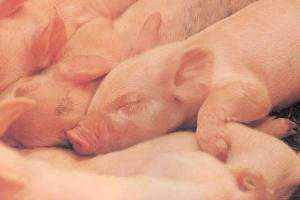No easy alternatives to surgical castration of piglets

Four alternatives to surgical castration of piglets were outlined by scientists from Aarhus University in a comprehensive report – the conclusion is that none of the four alternatives are easy to implement in Danish pig production here and now.
There are no easy alternatives to surgical castration – an issue that has again attracted a lot of attention following the transmission of a DR programme in early 2014 which cast doubts on the welfare of pigs on Danish pig farms – exemplified by the use of surgical castration. This is one of the conclusions of a major study into alternatives to surgical castration, which scientists at Aarhus University prepared for the Danish Veterinary and Food Administration.
Castration of male pigs is common practice in many countries and is carried out to prevent boar taint of the meat that ends up on the dinner table. But the EU Commission and numerous organisations have voluntarily pledged to cease castration by 1 January 2018, and scientists at Aarhus University were therefore commissioned to analyse possible alternatives.
Another reason why the search for alternatives to the castration of piglets was launched was because a summit meeting with the pig industry hosted by the Minister for Food, Agriculture and Fisheries in March 2014 resulted in a similar declaration that castration without the use of anaesthetics would be banned in Denmark by 2018 at the latest.
In the report the scientists have looked into the following realistic alternatives to surgical castration and undertaken a cost-benefit analysis of their implementation within a 2‒5 year time frame:
1) An entire male production: reducing boar taint through diet, breed selection, management and housing conditions
2) immunocastration (male pigs are functionally castrated via two vaccinations)
3) sperm sexing
4) breeding your way out of the problem
These are the alternatives that scientists have looked at. All four options have both advantages and disadvantages.
Both the entire male pig production and immunocastration can be completed within two to five years. Both methods will improve animal welfare in early life, but there are also challenges:
“Both alternatives may reduce welfare of the pigs for a shorter or longer period later in life as a result of increased aggression and mounting behaviour if management and the social or physical environments are not adjusted,” explains Bent Borg Jensen, senior researcher at the Department of Animal Science and main author of the report, and continues:
“It is not possible at this stage to determine whether male pig production and immunocastration will generally improve animal welfare compared with surgical castration, since the economic scope for welfare improvements with either of these methods is limited.”
Both alternatives may be profitable at farm level, the report stresses. However, the implementation of an entire male production and immunocastration can bring new challenges for the pig sector, which must take account of consumer attitudes in the export markets and the expected increase in boar-tainted meat. Since the vaccine used by immunocastration is not species-specific but also works on humans, there is concern about consumer attitudes towards immunocastration despite an almost non-existent risk. An entire male production also requires better sorting procedures at the slaughterhouses to remove the pigs that are tainted.
This sorting method has a high priority in the pig industry, which prefers an entire male pig production as an alternative to castration, but there is a qualification.
“There is currently no internationally agreed and validated on-line method for evaluating carcasses that meets the requirements of a highly streamlined industry,” says Jensen.
The other two alternatives, gender selection and breeding against boar taint, are described as promising, but there is a need for further development of the techniques associated with gender selection while breeding against boar taint assumes that the analyses carried out by the pig sector show that there is sufficient basis for this.
• Read DCA Report No. 42 “Alternatives to surgical castration in Danish pig production – a position review“.
Further information: Senior researcher Bent Borg Jensen, Department of Animal Science, telephone: +45 8715 8067, email: BentBorg.Jensen@agrsci.dk
Source: Søren Tobberup Hansen, Aarhus University











